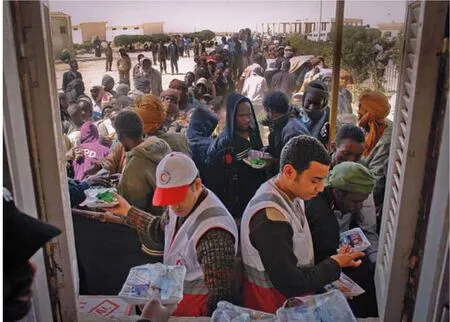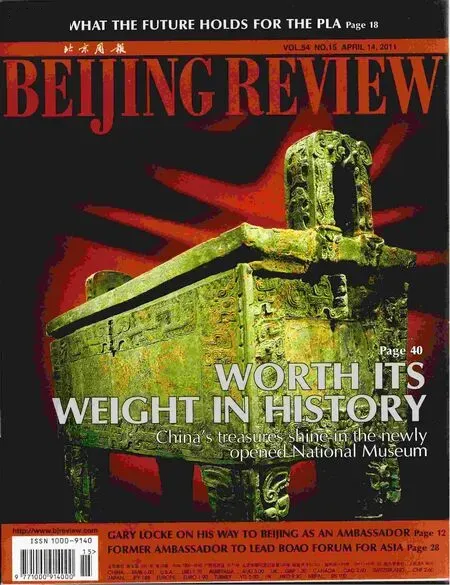Ripples From The Arab World
2011-10-14ByMEIXINYU
By MEI XINYU
Ripples From The Arab World
By MEI XINYU
Turmoil in the Middle East sparks global economic concerns

The massive upheavals sweeping the Arab world started on January 14 this year when Tunisian President Zine El Abidine Ben Ali fled abroad after protesters demanded he step down as the country’s leader. Egyptian President Hosni Mubarak followed in a similar fashion, resigning in the face of protests on February 11.
Libya, too, became a hotspot of social unrest in March as protests escalated into a civil war that eventually became an international con fl ict. France, the United States and the UK have since joined the fray in support of Libyan rebels trying to oust Libyan leader Muammar Gadda fi, a ruler of that country for more than 40 years.
This growing turmoil has severely impacted these countries’ economies and the lives of their people. Now, the ripple effect is expanding, sending shock waves through international commodity and fi nancial markets.
Behind the protests
Economically speaking, the per-capita income of each country that has experienced or is experiencing social unrest and their economic situations in general are not that bad, compared with other countries in the Middle East.
The UN’sStatistical Yearbooklists Libya’s 2008 per-capita GDP at $14,479,Tunisia’s at $3,955, Egypt’s at $2,162,Algeria’s at $4,588, and Bahrain’s at $27,248.Tunisia, the fi rst nation to undergo a shift in government leadership, has enjoyed a 5-percent average annual GDP growth rate in the past 20 years—a feat that has attracted a fl ood of attention from across the world.
The ultimate cause for civil unrest across the Middle East was a high unemployment rate that left many young people without jobs.Those young people became fed up with alltalk-no-action politicians who did nothing to improve people’s lives—so they demanded change. The prevalence of corruption and social injustice added to people’s dissatisfaction.
In fact, the high unemployment rate among young people was largely due to Arab countries’ rapid population growth and defective economic structure. Also, while natural resource industries—oil and natural gas—prospered, other industries remained underdeveloped and unable to provide a solid base for job growth.
Oil woes
Why cannot the oil industry coexist with manufacturing industries?
First of all, the oil revenues of the countries in question negatively impacted their manufacturing industries. As revenues from oil exports increased, a large quantity of petrodollars poured in, strengthening the countries’ currencies. As a result, even though the prices of their manufactured goods did not increase domestically, they went up in the international market, while the prices of imported products dropped. This undermined the competitiveness of oil-exporting countries’ products, causing consumers to buy goods from other countries instead of domestically produced ones.
In addition, an industry’s development cannot go without labor, capital, land and other factors of production. The oil industry de fi nitely has the upper hand in this respect.Able to provide higher salaries, the oil industry absorbed a disproportionately large number of skilled workers in oil-rich Arab countries, leaving other industries with the leftovers of the labor pool. Higher pro fi t margins also allowed oil companies to obtain a larger amount of investment. In this way, the oil industry realized expansion at the expense of other industries.
This labor drain has been common throughout history. The UK, Norway, the Netherlands and other countries in northern Europe experienced this trend when drilling for oil in the North Sea in the 1970s. Also, Russia has a massive revenue stream from oil exports,but has had to witness the decline of its light industries and traditional heavy industries.
For years, oil-exporting countries in the Middle East have vigorously promoted economic diversi fi cation. But few countries have seen noticeable results. Many countries’non-oil industries lacked international competitiveness in product prices and quality.Amid trade liberalization, these industries were forced to depend on government subsi-dies to survive. Some high-income countries also spent a large amount of money developing industries clearly incompatible with local natural conditions, such as planting wheat in the arid region.
Although Libya’s oil exports account for only 3.1 percent of the world’s total, this gap will still be huge and not easily filled by Saudi Arabia or other oil exporters in the Middle East
Economic blows
The political turmoil has made it even more dif fi cult for countries in the Middle East to follow through with economic restructuring. It also caused natural resources industries to decrease as well or even halt production.In February, Libya’s crude oil output dropped to 1.39 million barrels a day from 1.58 million barrels a day in January. Before foreign military intervention started on March 19, this number fell to below 400,000 barrels a day,less than a quarter of its normal output.
The tourist industry in the region has all but collapsed, with international and domestic travelers seeking safer, less tumultuous destinations. Construction of houses and bridges, as well as water pipelines, stopped. Young skilled workers, along with foreign workers essential to the normal operation of the local economies,fl ed away, as did foreign capital.
To make matters worse, previously suppressed anti-Gaddafi forces were able to rebound. After escalating violence forced almost all foreign companies, along with millions of foreign workers, out of Libya,extremist forces shifted their attacks against sub-Saharan Africans living and working in Libya. The UN News Center said Libyan rebels were compelling sub-Saharan Africans to leave the country. Many sub-Saharan Africans’ passports and of fi cial work documents were con fi scated and destroyed.
Foreign companies—including but not limited to oil and natural gas companies, telecommunications companies and engineering contractors—played an indispensable role in Middle East countries’economy and society.
The turmoil has already put the countries’economic future in jeopardy. Before starting to rebuild their economies, they will have to compensate foreign companies and residents for their losses. If the chaos continues, they will suffer even bigger losses.
Spillover effects
The impact of the situation rippling through the Middle East will soon be felt on the international commodity market. Capital will fl ow away from Arab countries, seeking safer havens. The turmoil will also cast more uncertainties over regional and global political situation.
Had the civil war in Libya not escalated into an international conflict, commodity prices, especially oil prices, would have dropped. If the West had not intervened,Gaddafi’s loyalist forces would have occupied rebel stronghold Benghazi and ended Libya’s civil war quickly, thus eliminating the surge in oil prices by providing security to Libya’s oil resources.
As a result of the intervention, the war will be prolonged, as will the negative impact on Libya’s oil production. If the West’s bombing damages Libyan oil fields and transportation facilities, international oil supply will certainly take a hit. Although Libya’s oil exports account for only 3.1 percent of the world’s total, this gap will still be huge and not easily fi lled by Saudi Arabia or other oil exporters in the Middle East.
The European market will be hit the hardest, since it’s a major destination for Libyan oil. Many European oil re fi neries are made to use Libya’s light crude oil, as opposed to oil produced elsewhere.
Since the surge in oil prices in the 1970s,petrodollars from Arab countries have become a significant force in international financial markets. If the political disturbance continues in the Middle East, large amounts of capital will fi nd markets elsewhere in the world. This will de fi nitely have an impact on international fi nancial markets—impacts that will be shown in exchange rates and asset prices.
The author is an associate research fellow with the Chinese Academy of International Trade and Economic Cooperation under the Ministry of Commerce

(Left)CAMP LIFE: Refugees stranded by bloodyclashes in Libya line up to get food and water from the Egyptian Red Crescent on the Libyan-Egyptian border on March 29

SURGING OIL PRICES: A man refuels his car at a gas station in Vienna,Austria, on March 14. International oil prices soared in the wake of the Middle East turmoil
